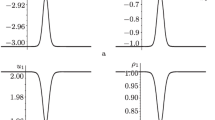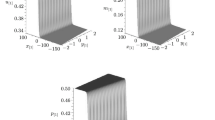Abstract
An explicit reciprocal transformation between a two-component generalization of the Camassa–Holm equation, called the 2-CH system, and the first negative flow of the AKNS hierarchy is established. This transformation enables one to obtain solutions of the 2-CH system from those of the first negative flow of the AKNS hierarchy. Interesting examples of peakon and multi-kink solutions of the 2-CH system are presented
Similar content being viewed by others
References
Abenta S., Grava T. Modulation of Camassa–Holm equation and reciprocal transformations. math-ph/0506042
Ablowitz M.J., Kaup D.J., Newell A.C., Segur H. (1974). The inverse scattering transform-Fourier analysis for nonlinear problems. Stud. Appl. Math. 53:249–315
Alber M.S., Camassa R., Fedorov Yu.N., Holm D.D., Marsden J.E. (2001). The complex geometry of weak piecewise smooth solutions of integrable nonlinear PDEs of shallow water and Dym type. Comm. Math. Phys. 221:197–227
Antonowicz M., Fordy A.P. (1987). Coupled K dV equations with multi-Hamiltonian structures. Physica D28:345–357
Antonowicz M., Fordy A.P. (1988). Coupled Harry Dym equations with multi-Hamiltonian structures. J. Phys. A21:L269–L275
Antonowicz M., Fordy A.P. (1989). Factorisation of energy dependent Schrödinger operators: Miura maps and modified systems. Comm. Math. Phys. 124:465–486
Beals R., Sattinger D.H., Szmigielski J. (2000). Multipeakons and the classical moment problem. Adv. Math. 154:229–257
Camassa R., Holm D.D. (1993). An integrable shallow water equation with peaked solitons. Phys. Rev. Lett. 71:1661–1664
Camassa R., Holm D.D., Hyman J.M. (1994). A new integrable shallow water equation. Adv. Appl. Mech. 31:1–33
Constantin A. (2001). On the scattering problem for the Camassa–Holm equation. R. Soc. Lond. Proc. Ser. A Math. Phys. Eng. Sci. 457:953–970
Constantin A., McKean H.P. (1999). A shallow water equation on the circle. Comm. Pure Appl. Math. 52:949–982
Constantin A., Strauss W.A. (2002). Stability of the Camassa–Holm solitons. J. Nonlinear Sci. 12:415–422
Constantin A., Strauss W.A. (2000). Stability of peakons. Comm. Pure Appl. Math. 53:603–610
Degasperis, A., Holm, D.D., Hone, A.N.W.: Integrable and non-integrable equations with peakons. In: Nonlinear physics: theory and experiment, II (Gallipoli, 2002), pp. 37–43, World Scientific, River Edge, (2003).
Dubrovin, B., Zhang, Y.: Normal forms of integrable PDEs, Frobenius manifolds and Gromov–Witten invariants. math.DG/0108160
Dubrovin, B., Liu, S.Q., Zhang, Y.: On Hamiltonian perturbations of hyperbolic systems of conservation laws, I: quasi-triviality of bi-Hamiltonian perturbations. Commun. Pure Appl. Math. (to appear) math.DG/0410027
Falqui, G., On a two-component generalization of the CH equation. In: Talk given at the conference “Analytic and geometric theory of the Camassa–Holm equation and Integrable systems”, Bologna (2004)
Fokas A.S. (1995). On a class of physically important integrable equations. Physica D87:145–150
Fuchssteiner B. (1996). Some tricks from the symmetry-toolbox for nonlinear equations: Generalizations of the Camassa–Holm equation. Physica D95:229–243
Fuchssteiner B., Fokas A.S. (1981). Symplectic structures, their Bäcklund transformations and hereditary symmetries. Physica D4:47–66
Gu C.H., Zhou Z.X. (1987). On the Darboux matrices of Bäcklund transformations for AKNS systems. Lett. Math. Phys. 13:179–187
Hone A.N.W. (1999). The associated Camassa–Holm equation and the K dV equation. J. Phys. A 32:L307–L314
Jaulent M., Jean C. (1976). The inverse problem for the one-dimensional Schrödinger equation with an energy-dependent potential. I. Ann. Inst. H. Poincar Sect. A (N.S.) 25:105–118
Johnson R.S. (2003). On solutions of the Camassa–Holm equation. R. Soc. Lond. Proc. Ser. A Math. Phys. Eng. Sci. 459:1687–1708
Li Y.S., Zhang J.E. (2004). The multiple-soliton solution of the Camassa–Holm equation. R. Soc. Lond. Proc. Ser. A Math. Phys. Eng. Sci. 460:2617–2627
Li, Y.S., Zhang, J.E.: Analytical multiple-soliton solution of the Camassa–Holm equation. Preprint 2004, J. Nonlinear Math. Phys. (to appear)
Liu S.Q., Zhang Y. (2005). Deformations of semisimple bihamiltonian structures of hydrodynamic type. J. Geom. Phys. 54:427–453
Martĺnez Alonso L. (1980). Schrödinger spectral problems with energy-dependent potentials as sources of nonlinear Hamiltonian evolution equations. J. Math. Phys. 21:2342–2349
Matveev V.B., Salle M.A. (1991). Darboux transformations and solitons In: Springer series in nonlinear dynamics. Springer, Berlin Heildelberg New York
McKean H. (2003). The Liouville correspondence between the Korteweg-de Vries and the Camassa-Holm hierarchies. Dedicated to the memory of Jürgen K. Moser. Comm. Pure Appl. Math. 56:998–1015
McKean H. (2004). Breakdown of the Camassa–Holm equation. Comm. Pure Appl. Math. 57:416–418
Schiff J. (1998). The Camassa–Holm equation: a loop group approach. Physica D 121(1–2):24–43
Author information
Authors and Affiliations
Corresponding author
Additional information
Mathematics Subject Classifications (2000). 35Q53, 37K35
Rights and permissions
About this article
Cite this article
Chen, M., liu, SQ. & Zhang, Y. A Two-component Generalization of the Camassa-Holm Equation and its Solutions. Lett Math Phys 75, 1–15 (2006). https://doi.org/10.1007/s11005-005-0041-7
Received:
Revised:
Published:
Issue Date:
DOI: https://doi.org/10.1007/s11005-005-0041-7




